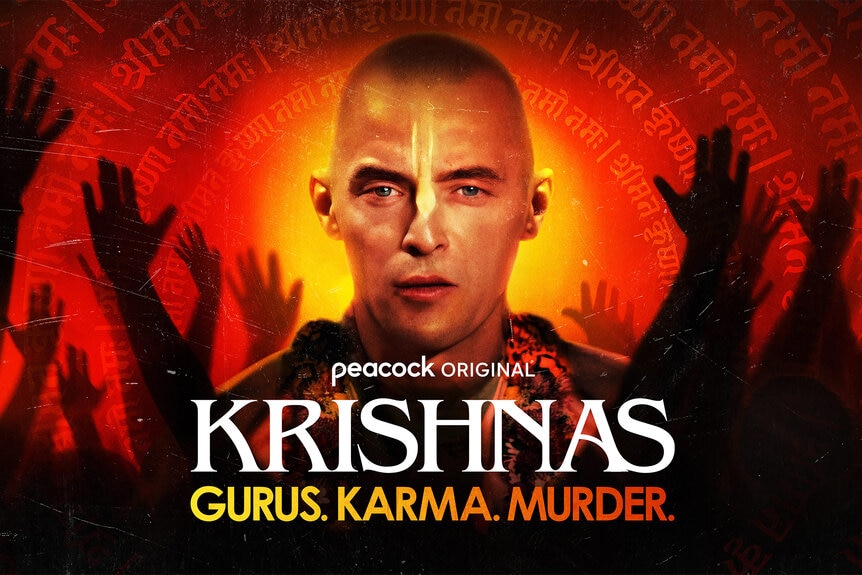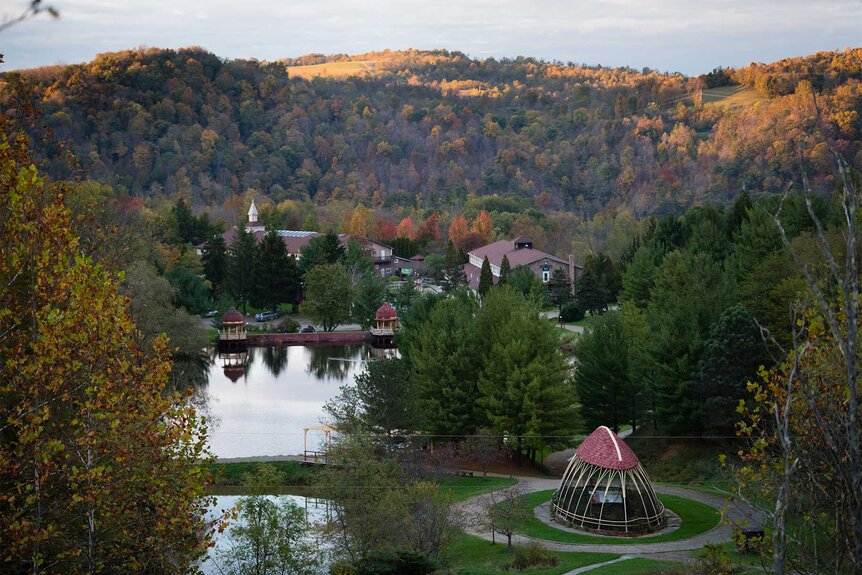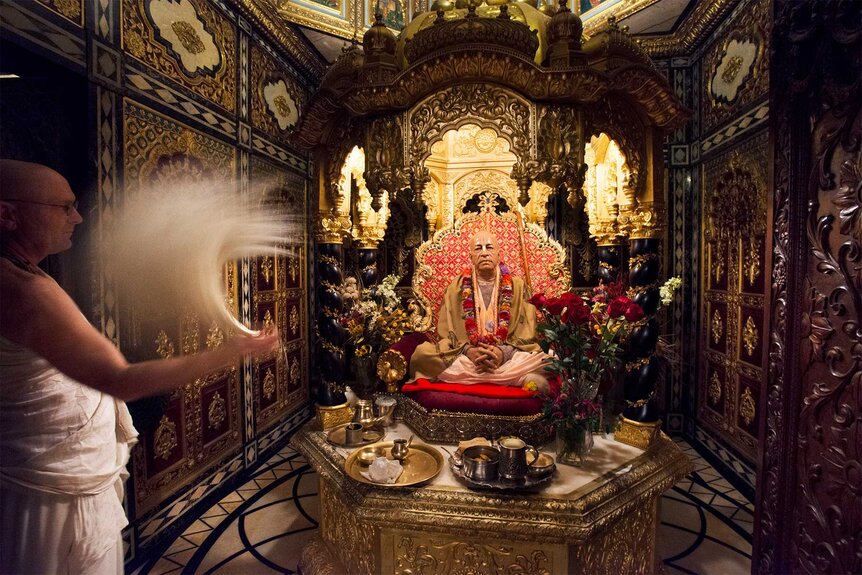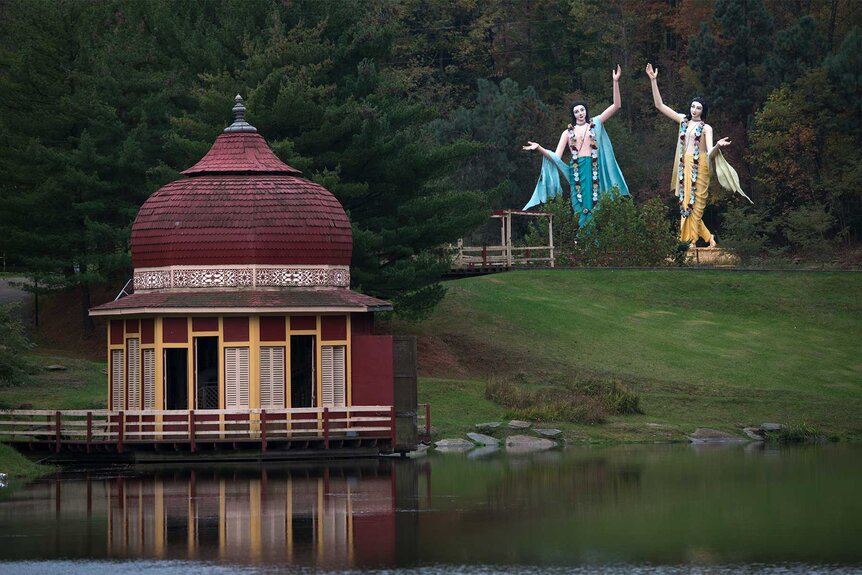Create a free profile to get unlimited access to exclusive videos, breaking news, sweepstakes, and more!
Krishnas: Gurus. Karma. Murder: Everything to Know About the Hare Krishna Scandal
Although founded on principles of peace, the Hare Krishna community known as New Vrindaban fell victim to.a cunning and ruthless leader, who led followers into a world of crime, murder and child abuse.
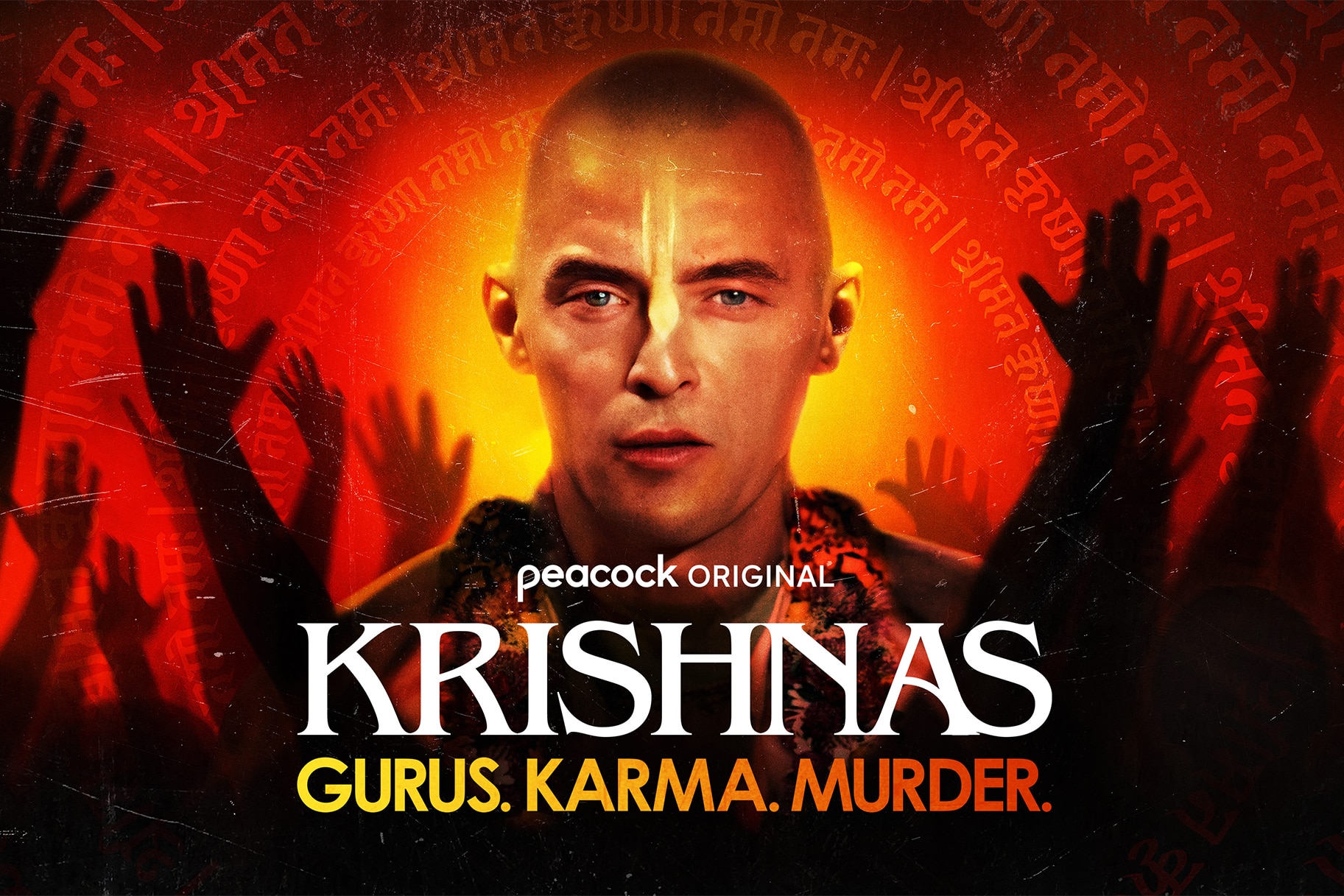
The Hare Krishna movement was founded on the ideas of peace and enlightenment, but one rogue disciple led some followers into a dark world of crime, child abuse and murder.
Peacock’s Krishnas: Gurus. Karma. Murder. follows the trail that Keith Ham, also known as Kirtanananda Swami, led followers down in his insatiable quest for power and control at a rural West Virginia farm turned gold-laden palace known as New Vrindaban.
“Kirtananda…was triggered by all this power, he not only has these dark ideas in his head, but he actually has the power to carry out his fantasies,” said Howard Resnick, a former Hare Krishna guru once known as Hridayananda Das.
RELATED: The Jonestown Massacre: Everything to Know About the Deadly Cult and Its Leader
Who are the Hare Krishnas?
As a branch of Hinduism, the roots of the Hare Krishna movement can be traced all the way back to the 16th century when Sri Chaitanya of Bengal instituted the belief that chanting God’s name held great power and should be shared with others, according to NPR,
The movement, formally known as the International Society of Krishna Consciousness (ISKCON), was brought to the United States in 1966 by Srila Prabhupada.
The religion centers on the belief that every living thing has a soul and, as a result, followers don’t eat meat. They also don’t believe in getting intoxicated, drinking coffee, gambling or sex outside of marriage and typically adopt a philosophy of non-materialism.
“Our faith tells us we are eternal, like God is eternal. We are the soul and not the body and depending on actions we do, we take birth again,” temple President Jaya Krsna Das explained in the three-part documentary. “So, we are in this endless cycle of births and deaths in this world, based on the Karma of our past lives. Our goal is that we can escape this and go to the spiritual world, where everything is bliss.”
Prabhupada capitalized on the hippy movement already in full-swing in America to find young people looking for a new way to view the world.
“What drew people to him was music. The whole philosophy is based on the chanting of transcendental sounds,” recalled William Ehrlichman, an early devotee and former guru once known as Bhagavan Das.
Ehrlichman dropped out of medical school to join Prabhupada, shaved his head as male followers were encouraged to do and adopted the more mystical, spiritual name of Bhagavan Das.
Who is Keith Ham, also known as Kirtanananda Swami?
Another early devotee was a man named Keith Ham. Ham, who was born in Peekskill, New York, was the son of a Southern Baptist minister, The Associated Press reported in 2011.
When he crossed paths with Prabhupada, Ham, also known as Kirtanananda Swami, had been getting his doctorate in history, but gave it up to become a devoted Hare Krishna, even taking a vow of celibacy known as sannyasi in 1967.
“He had a real work ethic, I mean he was just work, work, work,” Resnick recalled in Krishnas: Gurus. Karma. Murder. “I knew from the very beginning, his maybe two most characteristic features were ability and ambition.”
Prabhupada began spreading the Hare Krishna movement across the world, but Ham was already seeking power of his own. He allegedly stole Prabhupada’s Bhagavad Gita manuscript, a book of scripture, and went to a publisher claiming to be the author, although the publishing house didn’t believe the claim.
The move put Ham at odds with Prabhupada, but he soon tried to get back in Prabhupada’s good graces by starting a Hare Krishna community in West Virginia on about 130 acres of land that he got on a 99-year lease from a local farmer.
The early days of the commune-like farm were described as a “slum” with people living in cars, farm buildings or dilapidated houses with no heat.
“It was pretty rough. We slept in the barn with the cows,” Ehrlichman said.
Ham’s goal was to build Prabhupada’s palace on the property and he and other members set to work to build a palace of gold on the land they called New Vrindaban.
RELATED: Self-Described 'Amish Stud' Plots With Married Mennonite Lover To Murder His Wife
What Murders Were Connected with New Vrindaban?
Just before Prabhupada’s death in 1977, the spiritual leader named a series of “gurus” who would continue his mission around the world.
Ham was named as one of the gurus and by 1980 New Vrindaban had become one of the largest Hare Krishna centers in the world, which only gave Ham more power over the followers.
After a group of men came on the property looking for one of their daughters, Ham became more militant and enlisted the help of follower and Vietnam veteran Thomas Drescher, also known as Tirtha, to provide protection.
According to Tom Westfall, a former detective sergeant with Marshall County, by the time he arrived on the farm, Drescher already had a criminal record involving past situations where “violence was used.”
Another New Vrindaban devotee that Ham often relied on was Charles St. Denis, also known as Chakradara.
“He was a very tall man, very jolly, very cheerful, at the same time, very straightforward, fearless,” his son Bhima-Karma Saragrahi recalled.
St. Denis was known to skirt the rules and kept long hair, drank and smoked marijuana. He was also quick to call out hypocrisy and confronted Ham about rumors that he had been sexually active with construction workers on the farm.
“My father complaining directly and publicly about Kirtananda’s immoral activities definitely created a large rift between them from that time on,” Saragrahi said.
When the farm’s accountant, Daniel “Dan” Reid, known as Daruka, caught St. Denis having an affair with his wife, he turned to Ham for help.
On June 10, 1983, Reid called St. Denis to come have a drink and bury the hatchet, but St. Denis didn’t realize that Drescher, Ham’s enforcer, was also secretly waiting at the home. St. Denis was never seen again.
For years, investigators would try to solve St. Denis disappearance, but in the meantime, the community was thriving financially. The religious group made its money by something called sankirtan, or devotional fundraising, and followers would often ask for donations at airports or sell literature.
Under Ham’s direction, New Vrindaban moved away from traditional fundraising methods to petty crime. His followers went out in public and pretended to be raising money for other, more well-known charities like Meals on Wheels.
Although they didn’t have the proper copyright, they produced stickers and baseball caps promoting college teams to sell them to fans and had the women in the group go out in fundraising teams across the country.
“They would send the teams out on a college football weekend and the women would walk through the parking lots and they would assert, this is for Save the Children, this is for Lonely Children in America, whatever they could make up and sell this material which they were paying cents on the dollars for,” former FBI Agent Jeff Banwell said. “They would bring in close to a million dollars a weekend.”
Followers also alleged that Ham encouraged violence against women and there were reports of physical and sexual abuse of children at the school in the community.
“Kids got their arms broken from being yanked and roughly handled around, constantly being beaten in many different ways,” Saragrahi, once a student there himself, said.
Steve Bryant, a former devotee, planned to blow the whistle about the crimes going on at the farm.
“He was picking up momentum and getting more and more information, more and more first-hand accounts and he was also a catalyst, and I feel that he was emboldening people to talk,” said David Gold, Bryant’s former attorney.
But, before he could ever expose the activities, Bryant was killed on May 22, 1986. He was shot twice in the head while sitting in his parked van near a Hare Krishna temple in Los Angeles, UPI reported in 1991.
What happened to Thomas Drescher?
Los Angeles homicide detectives were able to link Drescher to Bryant’s murder with the help of Randall Gorby, a Marshall County resident who often helped the Hare Krishnas purchase land.
Gorby told West Virginia state police that Drescher told him he had been hired to kill Bryant. Police convinced Gorby to tape his next conversation with the Vietnam veteran.
During the recording, Drescher told Gorby that Ham had “counted” the money to pay for the hit “personally.”
Shortly after making the recording, Gorby’s house blew up from a natural gas leak. Authorities suspected someone had disconnected the gas line in an effort to get rid of him. Although his body was nearly covered in burns, Gorby initially survived and was able to make a dying declaration at the hospital describing what he knew about Drescher’s involvement in the murders of both Bryant and St. Dennis.
Drescher was arrested in Ohio and went on trial first for the murder of St. Dennis. He was convicted and sentenced to life without parole.
Reid, who by now was working at a swanky Beverly Hills office, agreed to lead authorities to St. Denis’ body as part of a plea deal in his own case.
Reid detailed the horrific final moments of St. Denis’ life. After being lured to Reid’s home, Reid told authorities that Drescher shot him as he got out of his vehicle, then plunged a knife into his chest. The men rolled the still-alive St. Denis into plastic, and buried him in an underwater grave in a nearby stream.
“While he was under there, there was some evidence that he was still alive there trying to get out,” Saragrahi said.
Even after his conviction, Drescher refused to turn on Ham, pledging his allegiance to the spiritual leader in a 1988 interview with The Associated Press.
“I’ve been offered a deal if I implicate (Ham) in Bryant’s death, but I’m not going to,” he said.
Drescher was even elevated to the rank of Swami while behind bars.
“I think it was insurance to keep Thomas Drescher quiet to not implicate Kirtanananda,” Westfall said in the docu-series. “Here’s somebody who is serving life without mercy for murdering a devotee and yet he’s being elevated to the rank of Swami. So many people felt that it was an insult to the entire religion.”
Drescher was also later convicted of killing Bryant.
“Taking another person’s life is no small thing. It’s horrible. And being associated with it in any way is, is…It haunts you, you know, it’s just the worst thing,” Drescher said in audio played in the docu-series.
As of 2016, he was still in prison serving out his life sentence, according to WTOV.
Where is Keith Ham Now?
Although Drescher initially refused to turn against Ham, he later agreed to testify against him in Ham’s second trial in 1996 for racketeering, mail fraud and conspiracy to commit murder.
Mid-way through the trial, Ham agreed to a plea deal and pleaded guilty to one count of racketeering for his involvement in the fundraising scam and conspiracy to commit murder, according to The New York Times.
He was sentenced to 20 years behind bars, but was released after eight years due to his declining health.
He was barred from ever returning to New Vrindaban and moved to India in 2008, per The Associated Press. Ham died in 2011 after suffering from a myriad of health issues including kidney failure.
He was expelled from ISKCON in 1987 for violating the religion’s policies, according to ISKCON News.
Does the New Vrindaban Still Exist? See the West Virginia Palace
The murder convictions as well as allegations there had been rampant sexual abuse and physical abuse among the children in the school system, known as the gurukula, caused ISKCON to re-evaluate its practices.
They created an organization called the Children of Krishna in the 1990s to support child victims and formed a global child protective office to investigate past claims of abuse. They also revamped the gurukula system and redefined the power given to gurus.
Today, the palace at New Vrindaban still stands and is used as a place of worship.
“Part of our history is our International Society taking action against New Vrindaban and then over the years our society bringing New Vrindaban back into the fold, reparations being made, a chance for New Vrindaban to take corrective action,” said Anuradha Dasi, who works in the New Vrindaban communication department. “I’m very happy to be part of the history of reparation, I’m very happy to be becoming back from betrayal. We’re not going to deny what happened, but do our very, very best to make sure it doesn’t happen again.”
Prabhupada’s Palace of Gold, which is reminiscent of “an ancient Indian kingdom,” still stands and welcomes visitors from across the world, according to the organization's website. Visitors can take in the 31 stained glass windows, crystal chandeliers, gold, gemstones, mirrored ceilings, marbled floors and exquisite artwork.
“The windows, too, are works of art, especially the four exquisite ‘royal peacock windows’ each of which is crafted with more than 1,500 pieces of hand-crafted stained glass,” the website boasts.
Admission tickets range from $7 to $12.
